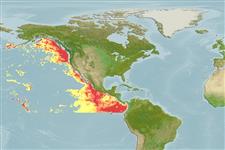Teleostei (teleosts) >
Ophidiiformes (Cusk eels) >
Ophidiidae (Cusk-eels) > Neobythitinae
Etymology: Holcomycteronus: Greek, holkos, -e, -on = something that pulls + Greek, mykter, -eros = nose + Greek, onos = hake.
More on author: Garman.
Environment: milieu / climate zone / depth range / distribution range
Ecology
Marine; bathydemersal; depth range 1570 - 4080 m (Ref. 34024). Deep-water
Eastern Pacific; 1570 - 4080 m..
Size / Weight / Age
Maturity: Lm ? range ? - ? cm
Max length : 35.6 cm TL male/unsexed; (Ref. 41039)
Short description
Identification keys | Morphology | Morphometrics
Robust body with rounded snout; eye diameter much shorter than snout; opercular spine strong; 2 median and a pair of basibranchial tooth patches; 7-11 developed rakers on anterior gill arch; pelvic fin rays flattened distally and somewhat thicker in males (Ref. 34024).
Uncommon species (Ref. 34024). Oviparous, with oval pelagic eggs floating in a gelatinous mass (Ref. 205).
Life cycle and mating behavior
Maturity | Reproduction | Spawning | Eggs | Fecundity | Larvae
Nielsen, J.G., D.M. Cohen, D.F. Markle and C.R. Robins, 1999. Ophidiiform fishes of the world (Order Ophidiiformes). An annotated and illustrated catalogue of pearlfishes, cusk-eels, brotulas and other ophidiiform fishes known to date. FAO Fish. Synop. 125(18):178p. Rome: FAO. (Ref. 34024)
IUCN Red List Status (Ref. 130435: Version 2024-1)
Threat to humans
Harmless
Human uses
Fisheries: of no interest
Tools
Special reports
Download XML
Internet sources
Estimates based on models
Preferred temperature (Ref.
123201): 1.8 - 2.3, mean 2 °C (based on 205 cells).
Phylogenetic diversity index (Ref.
82804): PD
50 = 0.5156 [Uniqueness, from 0.5 = low to 2.0 = high].
Bayesian length-weight: a=0.00380 (0.00167 - 0.00864), b=3.14 (2.94 - 3.34), in cm total length, based on LWR estimates for this (Sub)family-body shape (Ref.
93245).
Trophic level (Ref.
69278): 3.6 ±0.6 se; based on size and trophs of closest relatives
Resilience (Ref.
120179): Medium, minimum population doubling time 1.4 - 4.4 years (Assuming tmax>3).
Fishing Vulnerability (Ref.
59153): Low to moderate vulnerability (26 of 100).
